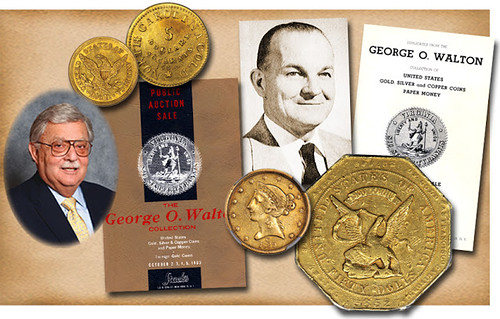
PREV ARTICLE
NEXT ARTICLE
FULL ISSUE
PREV FULL ISSUE
HARVEY STACK ON THE GEORGE O. WALTON COLLECTION
In his most recent blog entries, Harvey Stack discusses the George O. Walton collection. While widely known as the owner of one of the five 1913 Liberty head Nickels, Walton's true numismatic legacy goes far beyond that one famous coin. Here are some excerpts.
-Editor

George Walton had vast holdings of Charlotte and Dahlonega gold coins, plus the coins of the Bechtler family and Templeton Reid, as well as a large collection of paper money, including southern state bank notes, issued and used prior to the Civil War, and Confederate currency. For more information about the man, I reference what was written in a Stack’s catalog of his collection offered in 1963. As early as 1937 George Walton was well known to the Stack family. He would visit our shop and talk for hours with Joseph and Morton. They were amazed at how much this young man knew about southern currency. From these early encounters a mutual friendship and respect grew. When the Stacks needed guidance on the history and money of the pre-Civil War period, George Walton’s great knowledge in this area was put to use. George O. Walton was active in the American Numismatic Association, attended most conventions and also formed or participated in numerous coin clubs in the southeastern United States. Part of his livelihood came from being a bank inspector and appraiser for banks in the Carolinas, George, northern Florida and the mountainous areas of Virginia and Maryland. As he traveled through the towns and cities of these areas he made many friends and was also able to buy and sell southern gold coins and early paper money. Among the people served was the Reynolds family of tobacco fame and Dr. Conway Bolt, whose collection Stack’s sold in the early 1970s. Beyond his affection for southern gold, Walton also had substantial holdings of territorial gold, not only the private gold of the Carolinas and Georgia. He often had a quantity of $50 gold pieces with him as well as those that remained in his bank) and loved to display them at ANA shows. He had a friendly rivalry with Amon Carter, Jr. who also had a large collection. At one point, some other collectors challenged them that they could not put together an exhibit of more than 100 pieces. George and Amon accepted the challenge and at the next ANA convention, between them they showed 101 territorial gold slugs, octagonal and round. It was like seeing the contents of a Wells Fargo chest on display. The challengers could not believe their eyes and never underestimated George or Amon again. Unfortunately George, this knowledgeable numismatist and great friend of so many, was in a fatal automobile accident in 1962, on his way to a meeting of the Wilson-Goldsboro Coin Club. As was his style, he had with him many coins and these ended up spread over the highway. The police closed down the road and officers were assigned the task of picking up what they could find. Much was retrieved (but likely not all). After the collection was reassembled, it was given to Stack’s to sell at public auction by the Colonial-American National Bank of Roanoke, Virginia, who were the administrators of Walton’s estate. The collection was so voluminous that it took two Stack’s catalogs to present it for sale. The Charlotte and Dahlonega gold and the private gold coins of the Bechtlers and Templeton Reid would have been a landmark sale on their own. But George Walton had gold coins of all denominations in quantity. The legacy of George O. Walton is what his collection did for today’s collectors. By accumulating (some might say hoarding) coins from the Charlotte and Dahlonega mints he may have saved many of them from the melting pot. While people in the South did recognize these coins as their “local” currency and saved them, when the U.S. government in 1934 called in gold coins, many of these rarer pieces were turned in and melted along with more common gold. It was lucky that George Walton and other collectors of the period understood the rarity of these coins and sought them out. His trips throughout the South buying coins put many coins in his collection and the collections of those he sold them to, instead of the melting pot. Also in the Walton “Hoard” were the private gold coins issued by the Bechtler family during the 1830s, which made the gold found in the Carolina and Georgia hills usable as currency for goods and services in that area. The size of this accumulation, in today’s term, is almost unimaginable. George Walton had many hundreds of these pieces, which Stack’s offered in both of the sales, with particularly large lots sold in the October “main” sale. By having so many coins to offer, collectors at the sale and those who came later had a good supply of these rare federal gold issues, which kept them more affordable. If all these coins had been melted in the 1930s, the cost of the surviving coins would have been many times what they are today. His legacy was to make collecting these coins possible for the numismatists of the future, in much the same manner that the famous Colonel E.H.R. Green saved pre-1834 $5 and $10 gold coins from the same melting pot.
To read the complete articles, see:
The Numismatic Bibliomania Society is a non-profit organization promoting numismatic literature. See our web site at coinbooks.org. To submit items for publication in The E-Sylum, write to the Editor at this address: whomren@gmail.com To subscribe go to: https://my.binhost.com/lists/listinfo/esylum All Rights Reserved. NBS Home Page Contact the NBS webmaster 
|